Analysis of Residential Building Contracts: Processes, Stakeholders
VerifiedAdded on 2020/02/18
|23
|5224
|34
Report
AI Summary
This report provides a comprehensive analysis of residential building contracts, focusing on the renovation and extension of a residential building. It outlines the key processes involved, from appointing a managing contractor and selecting a design team to obtaining council approvals, preparing contracts, and overseeing demolition and construction. The report identifies various stakeholders, including the client, design team, contractor, suppliers, project manager, insurance companies, and local government authorities, detailing their respective roles and responsibilities. It further explores different contract options such as standard, fixed price, unit price, cost-plus, target cost, custom, and project management contracts, as well as project delivery methods like Design-Build, Design-Bid-Build, Construction Management, Management Contracting, Direct Management, and Alliancing. Finally, the report discusses relevant legislations concerning licenses, permits, finance, tax, levies, insurance, workplace health and safety, and environmental considerations. The report emphasizes the importance of stakeholder coordination and adherence to standards and regulations for successful project completion.
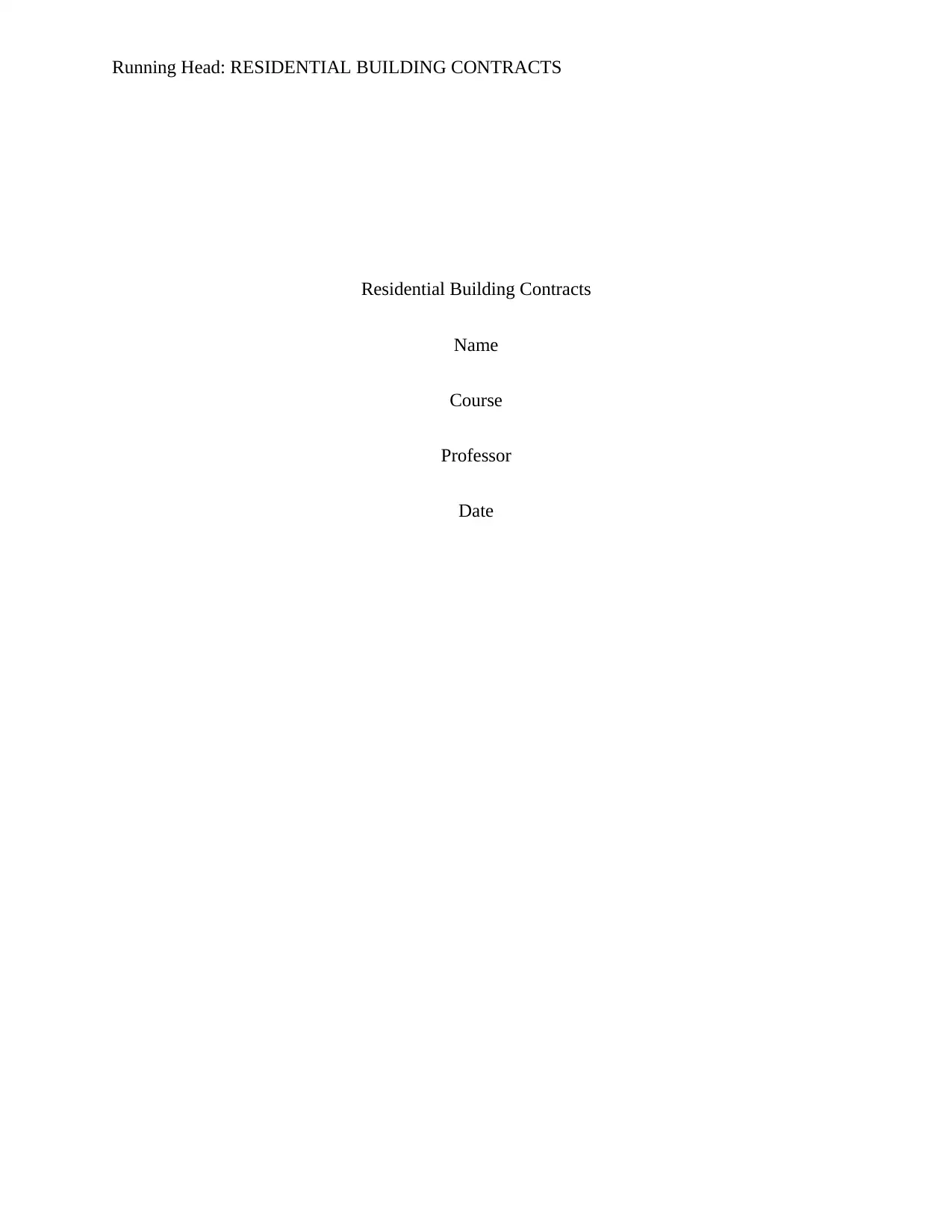
Running Head: RESIDENTIAL BUILDING CONTRACTS
Residential Building Contracts
Name
Course
Professor
Date
Residential Building Contracts
Name
Course
Professor
Date
Paraphrase This Document
Need a fresh take? Get an instant paraphrase of this document with our AI Paraphraser
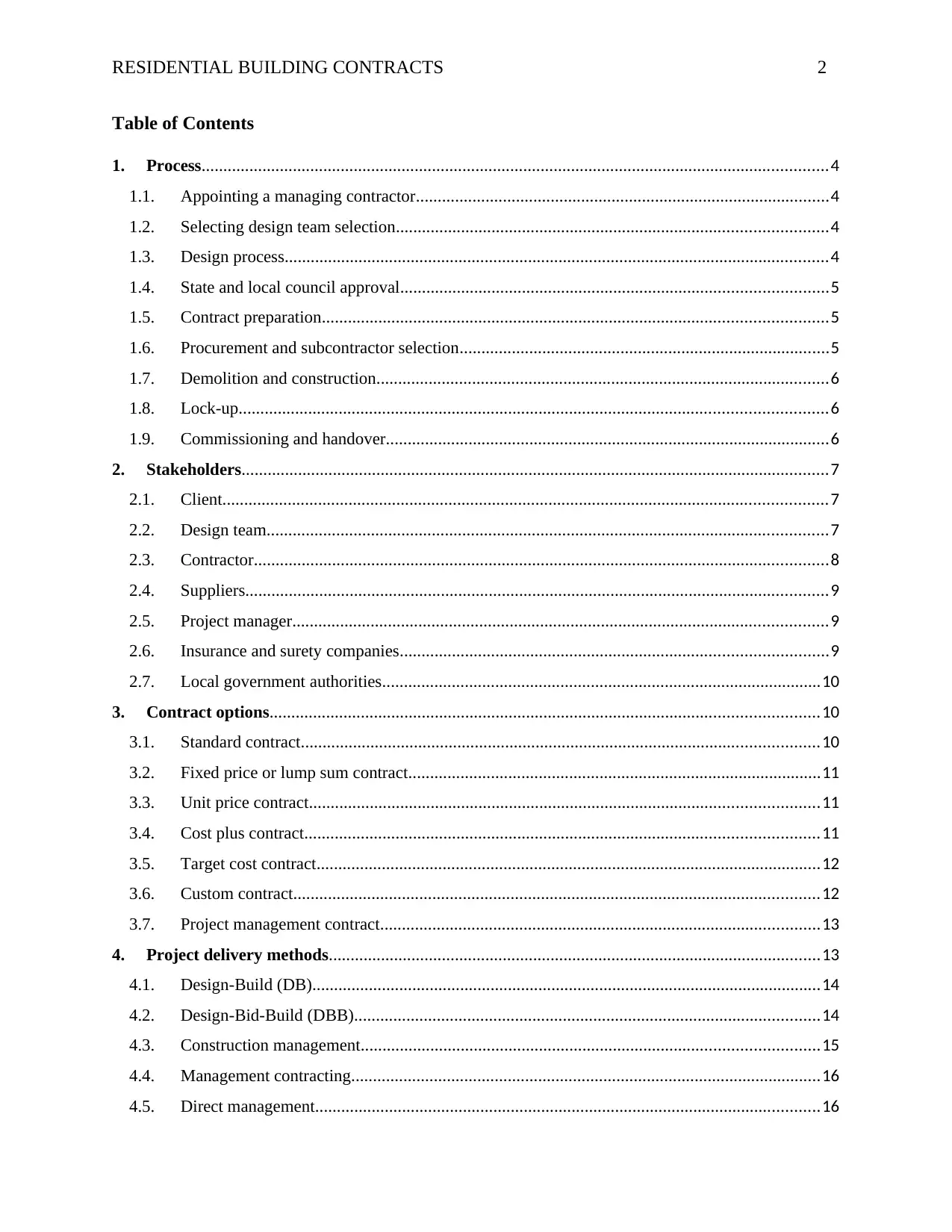
RESIDENTIAL BUILDING CONTRACTS 2
Table of Contents
1. Process................................................................................................................................................4
1.1. Appointing a managing contractor...............................................................................................4
1.2. Selecting design team selection...................................................................................................4
1.3. Design process.............................................................................................................................4
1.4. State and local council approval..................................................................................................5
1.5. Contract preparation....................................................................................................................5
1.6. Procurement and subcontractor selection.....................................................................................5
1.7. Demolition and construction........................................................................................................6
1.8. Lock-up.......................................................................................................................................6
1.9. Commissioning and handover......................................................................................................6
2. Stakeholders.......................................................................................................................................7
2.1. Client...........................................................................................................................................7
2.2. Design team.................................................................................................................................7
2.3. Contractor....................................................................................................................................8
2.4. Suppliers......................................................................................................................................9
2.5. Project manager...........................................................................................................................9
2.6. Insurance and surety companies..................................................................................................9
2.7. Local government authorities.....................................................................................................10
3. Contract options..............................................................................................................................10
3.1. Standard contract.......................................................................................................................10
3.2. Fixed price or lump sum contract...............................................................................................11
3.3. Unit price contract.....................................................................................................................11
3.4. Cost plus contract......................................................................................................................11
3.5. Target cost contract....................................................................................................................12
3.6. Custom contract.........................................................................................................................12
3.7. Project management contract.....................................................................................................13
4. Project delivery methods.................................................................................................................13
4.1. Design-Build (DB).....................................................................................................................14
4.2. Design-Bid-Build (DBB)...........................................................................................................14
4.3. Construction management.........................................................................................................15
4.4. Management contracting............................................................................................................16
4.5. Direct management....................................................................................................................16
Table of Contents
1. Process................................................................................................................................................4
1.1. Appointing a managing contractor...............................................................................................4
1.2. Selecting design team selection...................................................................................................4
1.3. Design process.............................................................................................................................4
1.4. State and local council approval..................................................................................................5
1.5. Contract preparation....................................................................................................................5
1.6. Procurement and subcontractor selection.....................................................................................5
1.7. Demolition and construction........................................................................................................6
1.8. Lock-up.......................................................................................................................................6
1.9. Commissioning and handover......................................................................................................6
2. Stakeholders.......................................................................................................................................7
2.1. Client...........................................................................................................................................7
2.2. Design team.................................................................................................................................7
2.3. Contractor....................................................................................................................................8
2.4. Suppliers......................................................................................................................................9
2.5. Project manager...........................................................................................................................9
2.6. Insurance and surety companies..................................................................................................9
2.7. Local government authorities.....................................................................................................10
3. Contract options..............................................................................................................................10
3.1. Standard contract.......................................................................................................................10
3.2. Fixed price or lump sum contract...............................................................................................11
3.3. Unit price contract.....................................................................................................................11
3.4. Cost plus contract......................................................................................................................11
3.5. Target cost contract....................................................................................................................12
3.6. Custom contract.........................................................................................................................12
3.7. Project management contract.....................................................................................................13
4. Project delivery methods.................................................................................................................13
4.1. Design-Build (DB).....................................................................................................................14
4.2. Design-Bid-Build (DBB)...........................................................................................................14
4.3. Construction management.........................................................................................................15
4.4. Management contracting............................................................................................................16
4.5. Direct management....................................................................................................................16
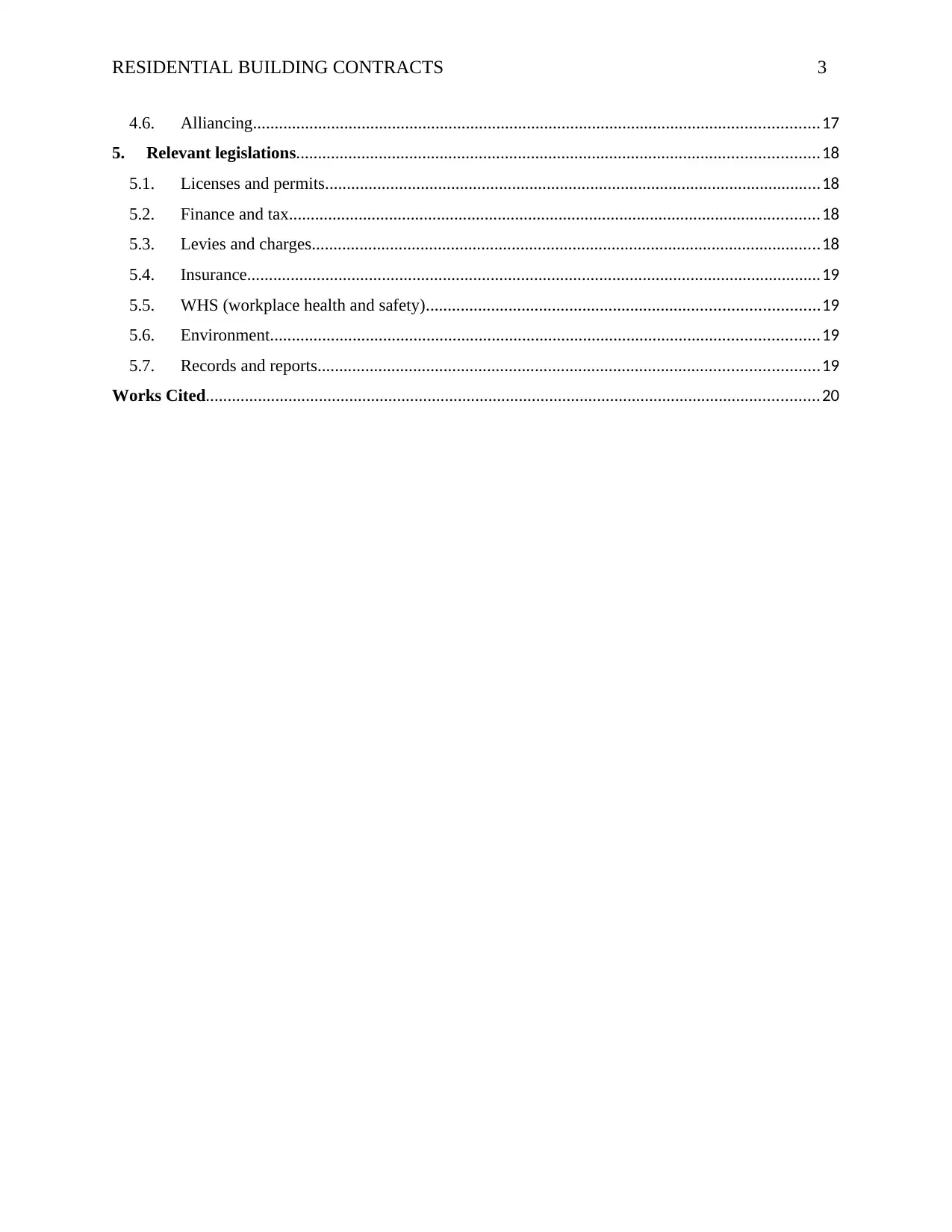
RESIDENTIAL BUILDING CONTRACTS 3
4.6. Alliancing..................................................................................................................................17
5. Relevant legislations........................................................................................................................18
5.1. Licenses and permits..................................................................................................................18
5.2. Finance and tax..........................................................................................................................18
5.3. Levies and charges.....................................................................................................................18
5.4. Insurance....................................................................................................................................19
5.5. WHS (workplace health and safety)..........................................................................................19
5.6. Environment..............................................................................................................................19
5.7. Records and reports...................................................................................................................19
Works Cited.............................................................................................................................................20
4.6. Alliancing..................................................................................................................................17
5. Relevant legislations........................................................................................................................18
5.1. Licenses and permits..................................................................................................................18
5.2. Finance and tax..........................................................................................................................18
5.3. Levies and charges.....................................................................................................................18
5.4. Insurance....................................................................................................................................19
5.5. WHS (workplace health and safety)..........................................................................................19
5.6. Environment..............................................................................................................................19
5.7. Records and reports...................................................................................................................19
Works Cited.............................................................................................................................................20
⊘ This is a preview!⊘
Do you want full access?
Subscribe today to unlock all pages.

Trusted by 1+ million students worldwide
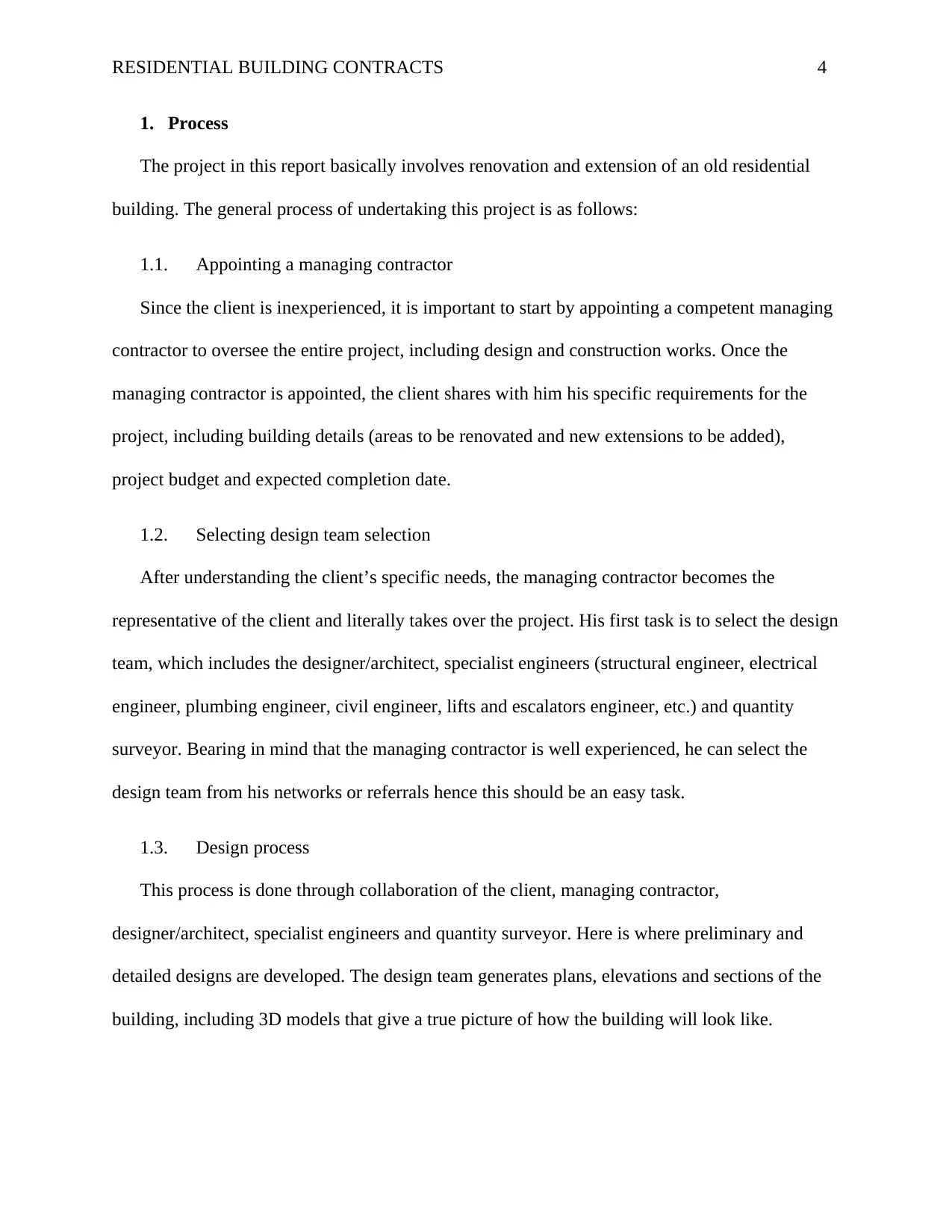
RESIDENTIAL BUILDING CONTRACTS 4
1. Process
The project in this report basically involves renovation and extension of an old residential
building. The general process of undertaking this project is as follows:
1.1. Appointing a managing contractor
Since the client is inexperienced, it is important to start by appointing a competent managing
contractor to oversee the entire project, including design and construction works. Once the
managing contractor is appointed, the client shares with him his specific requirements for the
project, including building details (areas to be renovated and new extensions to be added),
project budget and expected completion date.
1.2. Selecting design team selection
After understanding the client’s specific needs, the managing contractor becomes the
representative of the client and literally takes over the project. His first task is to select the design
team, which includes the designer/architect, specialist engineers (structural engineer, electrical
engineer, plumbing engineer, civil engineer, lifts and escalators engineer, etc.) and quantity
surveyor. Bearing in mind that the managing contractor is well experienced, he can select the
design team from his networks or referrals hence this should be an easy task.
1.3. Design process
This process is done through collaboration of the client, managing contractor,
designer/architect, specialist engineers and quantity surveyor. Here is where preliminary and
detailed designs are developed. The design team generates plans, elevations and sections of the
building, including 3D models that give a true picture of how the building will look like.
1. Process
The project in this report basically involves renovation and extension of an old residential
building. The general process of undertaking this project is as follows:
1.1. Appointing a managing contractor
Since the client is inexperienced, it is important to start by appointing a competent managing
contractor to oversee the entire project, including design and construction works. Once the
managing contractor is appointed, the client shares with him his specific requirements for the
project, including building details (areas to be renovated and new extensions to be added),
project budget and expected completion date.
1.2. Selecting design team selection
After understanding the client’s specific needs, the managing contractor becomes the
representative of the client and literally takes over the project. His first task is to select the design
team, which includes the designer/architect, specialist engineers (structural engineer, electrical
engineer, plumbing engineer, civil engineer, lifts and escalators engineer, etc.) and quantity
surveyor. Bearing in mind that the managing contractor is well experienced, he can select the
design team from his networks or referrals hence this should be an easy task.
1.3. Design process
This process is done through collaboration of the client, managing contractor,
designer/architect, specialist engineers and quantity surveyor. Here is where preliminary and
detailed designs are developed. The design team generates plans, elevations and sections of the
building, including 3D models that give a true picture of how the building will look like.
Paraphrase This Document
Need a fresh take? Get an instant paraphrase of this document with our AI Paraphraser
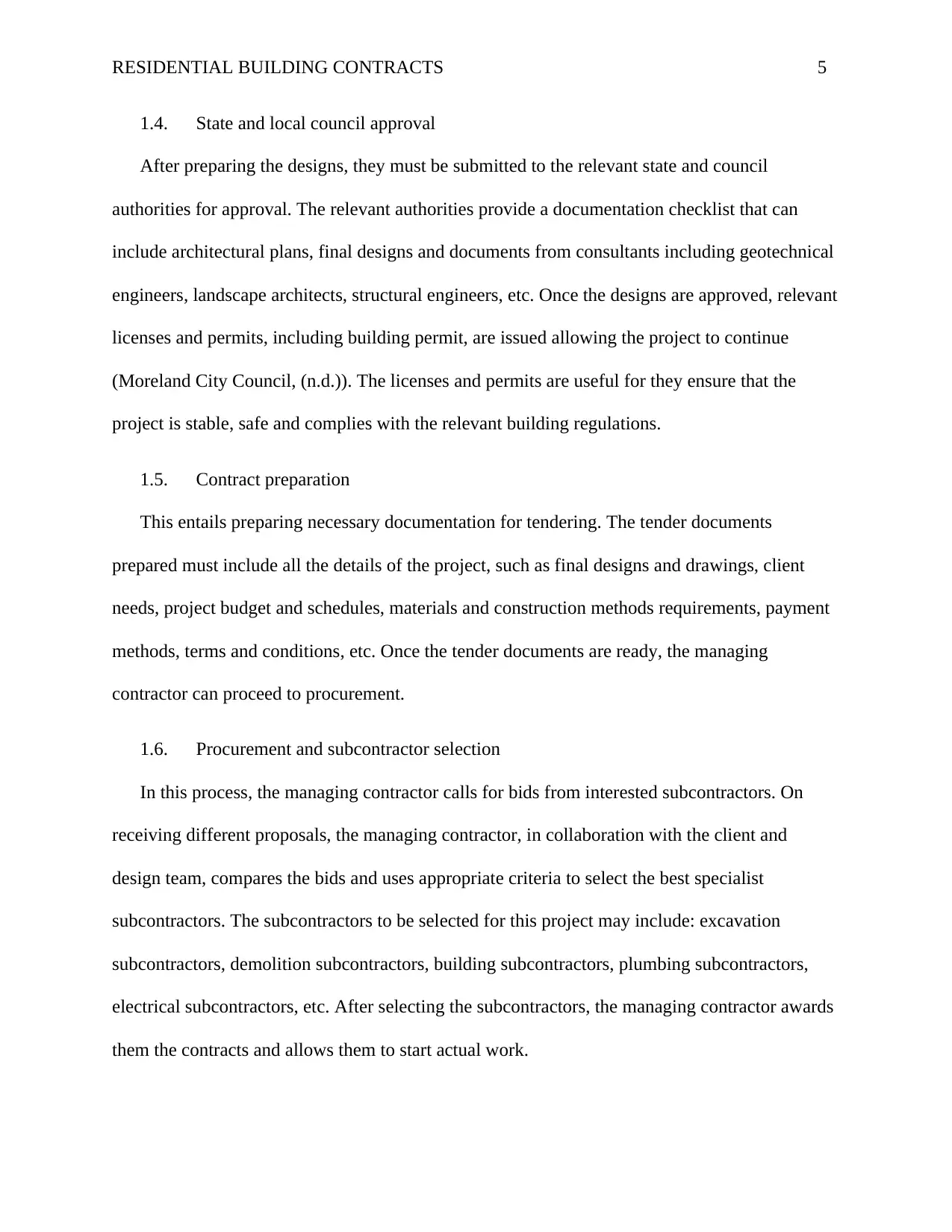
RESIDENTIAL BUILDING CONTRACTS 5
1.4. State and local council approval
After preparing the designs, they must be submitted to the relevant state and council
authorities for approval. The relevant authorities provide a documentation checklist that can
include architectural plans, final designs and documents from consultants including geotechnical
engineers, landscape architects, structural engineers, etc. Once the designs are approved, relevant
licenses and permits, including building permit, are issued allowing the project to continue
(Moreland City Council, (n.d.)). The licenses and permits are useful for they ensure that the
project is stable, safe and complies with the relevant building regulations.
1.5. Contract preparation
This entails preparing necessary documentation for tendering. The tender documents
prepared must include all the details of the project, such as final designs and drawings, client
needs, project budget and schedules, materials and construction methods requirements, payment
methods, terms and conditions, etc. Once the tender documents are ready, the managing
contractor can proceed to procurement.
1.6. Procurement and subcontractor selection
In this process, the managing contractor calls for bids from interested subcontractors. On
receiving different proposals, the managing contractor, in collaboration with the client and
design team, compares the bids and uses appropriate criteria to select the best specialist
subcontractors. The subcontractors to be selected for this project may include: excavation
subcontractors, demolition subcontractors, building subcontractors, plumbing subcontractors,
electrical subcontractors, etc. After selecting the subcontractors, the managing contractor awards
them the contracts and allows them to start actual work.
1.4. State and local council approval
After preparing the designs, they must be submitted to the relevant state and council
authorities for approval. The relevant authorities provide a documentation checklist that can
include architectural plans, final designs and documents from consultants including geotechnical
engineers, landscape architects, structural engineers, etc. Once the designs are approved, relevant
licenses and permits, including building permit, are issued allowing the project to continue
(Moreland City Council, (n.d.)). The licenses and permits are useful for they ensure that the
project is stable, safe and complies with the relevant building regulations.
1.5. Contract preparation
This entails preparing necessary documentation for tendering. The tender documents
prepared must include all the details of the project, such as final designs and drawings, client
needs, project budget and schedules, materials and construction methods requirements, payment
methods, terms and conditions, etc. Once the tender documents are ready, the managing
contractor can proceed to procurement.
1.6. Procurement and subcontractor selection
In this process, the managing contractor calls for bids from interested subcontractors. On
receiving different proposals, the managing contractor, in collaboration with the client and
design team, compares the bids and uses appropriate criteria to select the best specialist
subcontractors. The subcontractors to be selected for this project may include: excavation
subcontractors, demolition subcontractors, building subcontractors, plumbing subcontractors,
electrical subcontractors, etc. After selecting the subcontractors, the managing contractor awards
them the contracts and allows them to start actual work.
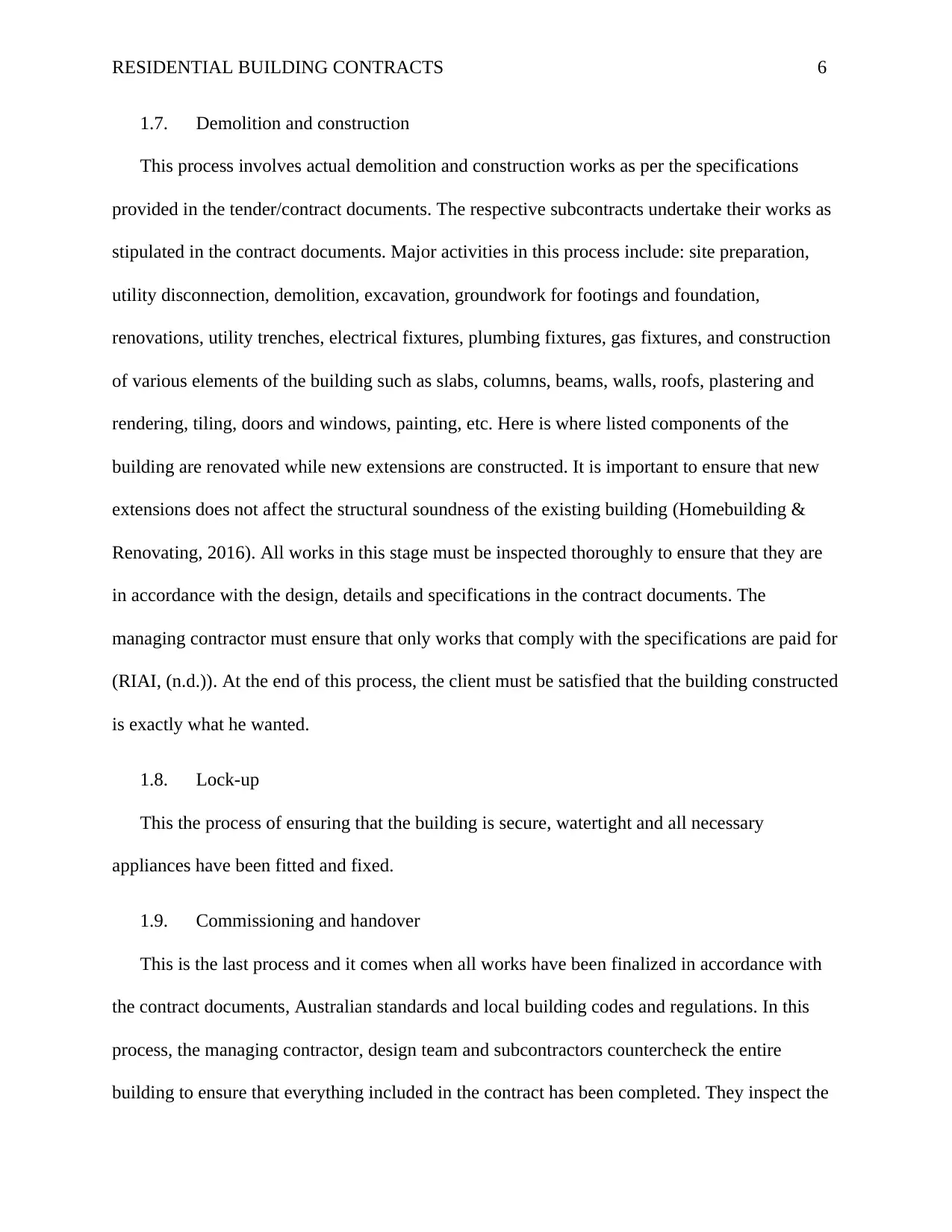
RESIDENTIAL BUILDING CONTRACTS 6
1.7. Demolition and construction
This process involves actual demolition and construction works as per the specifications
provided in the tender/contract documents. The respective subcontracts undertake their works as
stipulated in the contract documents. Major activities in this process include: site preparation,
utility disconnection, demolition, excavation, groundwork for footings and foundation,
renovations, utility trenches, electrical fixtures, plumbing fixtures, gas fixtures, and construction
of various elements of the building such as slabs, columns, beams, walls, roofs, plastering and
rendering, tiling, doors and windows, painting, etc. Here is where listed components of the
building are renovated while new extensions are constructed. It is important to ensure that new
extensions does not affect the structural soundness of the existing building (Homebuilding &
Renovating, 2016). All works in this stage must be inspected thoroughly to ensure that they are
in accordance with the design, details and specifications in the contract documents. The
managing contractor must ensure that only works that comply with the specifications are paid for
(RIAI, (n.d.)). At the end of this process, the client must be satisfied that the building constructed
is exactly what he wanted.
1.8. Lock-up
This the process of ensuring that the building is secure, watertight and all necessary
appliances have been fitted and fixed.
1.9. Commissioning and handover
This is the last process and it comes when all works have been finalized in accordance with
the contract documents, Australian standards and local building codes and regulations. In this
process, the managing contractor, design team and subcontractors countercheck the entire
building to ensure that everything included in the contract has been completed. They inspect the
1.7. Demolition and construction
This process involves actual demolition and construction works as per the specifications
provided in the tender/contract documents. The respective subcontracts undertake their works as
stipulated in the contract documents. Major activities in this process include: site preparation,
utility disconnection, demolition, excavation, groundwork for footings and foundation,
renovations, utility trenches, electrical fixtures, plumbing fixtures, gas fixtures, and construction
of various elements of the building such as slabs, columns, beams, walls, roofs, plastering and
rendering, tiling, doors and windows, painting, etc. Here is where listed components of the
building are renovated while new extensions are constructed. It is important to ensure that new
extensions does not affect the structural soundness of the existing building (Homebuilding &
Renovating, 2016). All works in this stage must be inspected thoroughly to ensure that they are
in accordance with the design, details and specifications in the contract documents. The
managing contractor must ensure that only works that comply with the specifications are paid for
(RIAI, (n.d.)). At the end of this process, the client must be satisfied that the building constructed
is exactly what he wanted.
1.8. Lock-up
This the process of ensuring that the building is secure, watertight and all necessary
appliances have been fitted and fixed.
1.9. Commissioning and handover
This is the last process and it comes when all works have been finalized in accordance with
the contract documents, Australian standards and local building codes and regulations. In this
process, the managing contractor, design team and subcontractors countercheck the entire
building to ensure that everything included in the contract has been completed. They inspect the
⊘ This is a preview!⊘
Do you want full access?
Subscribe today to unlock all pages.

Trusted by 1+ million students worldwide
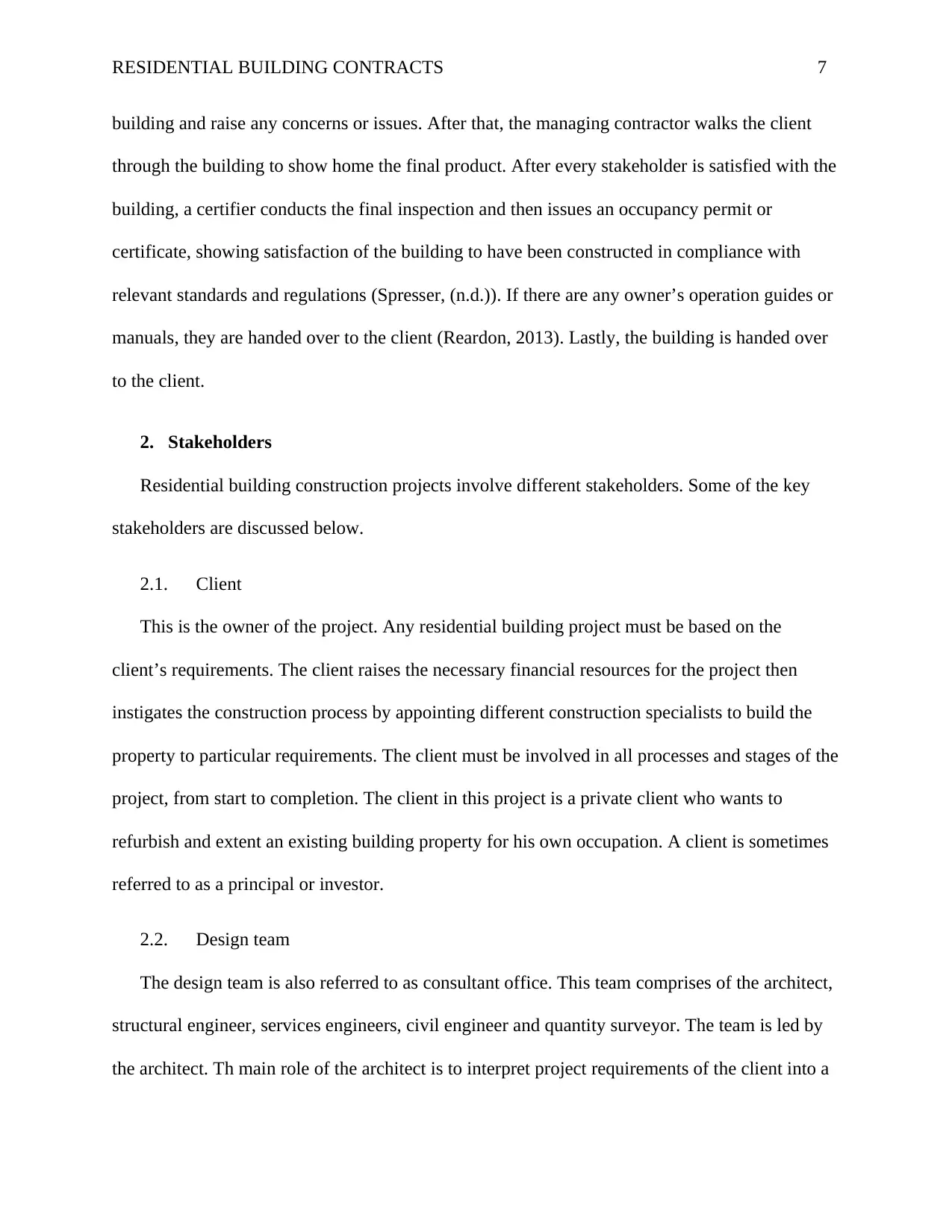
RESIDENTIAL BUILDING CONTRACTS 7
building and raise any concerns or issues. After that, the managing contractor walks the client
through the building to show home the final product. After every stakeholder is satisfied with the
building, a certifier conducts the final inspection and then issues an occupancy permit or
certificate, showing satisfaction of the building to have been constructed in compliance with
relevant standards and regulations (Spresser, (n.d.)). If there are any owner’s operation guides or
manuals, they are handed over to the client (Reardon, 2013). Lastly, the building is handed over
to the client.
2. Stakeholders
Residential building construction projects involve different stakeholders. Some of the key
stakeholders are discussed below.
2.1. Client
This is the owner of the project. Any residential building project must be based on the
client’s requirements. The client raises the necessary financial resources for the project then
instigates the construction process by appointing different construction specialists to build the
property to particular requirements. The client must be involved in all processes and stages of the
project, from start to completion. The client in this project is a private client who wants to
refurbish and extent an existing building property for his own occupation. A client is sometimes
referred to as a principal or investor.
2.2. Design team
The design team is also referred to as consultant office. This team comprises of the architect,
structural engineer, services engineers, civil engineer and quantity surveyor. The team is led by
the architect. Th main role of the architect is to interpret project requirements of the client into a
building and raise any concerns or issues. After that, the managing contractor walks the client
through the building to show home the final product. After every stakeholder is satisfied with the
building, a certifier conducts the final inspection and then issues an occupancy permit or
certificate, showing satisfaction of the building to have been constructed in compliance with
relevant standards and regulations (Spresser, (n.d.)). If there are any owner’s operation guides or
manuals, they are handed over to the client (Reardon, 2013). Lastly, the building is handed over
to the client.
2. Stakeholders
Residential building construction projects involve different stakeholders. Some of the key
stakeholders are discussed below.
2.1. Client
This is the owner of the project. Any residential building project must be based on the
client’s requirements. The client raises the necessary financial resources for the project then
instigates the construction process by appointing different construction specialists to build the
property to particular requirements. The client must be involved in all processes and stages of the
project, from start to completion. The client in this project is a private client who wants to
refurbish and extent an existing building property for his own occupation. A client is sometimes
referred to as a principal or investor.
2.2. Design team
The design team is also referred to as consultant office. This team comprises of the architect,
structural engineer, services engineers, civil engineer and quantity surveyor. The team is led by
the architect. Th main role of the architect is to interpret project requirements of the client into a
Paraphrase This Document
Need a fresh take? Get an instant paraphrase of this document with our AI Paraphraser
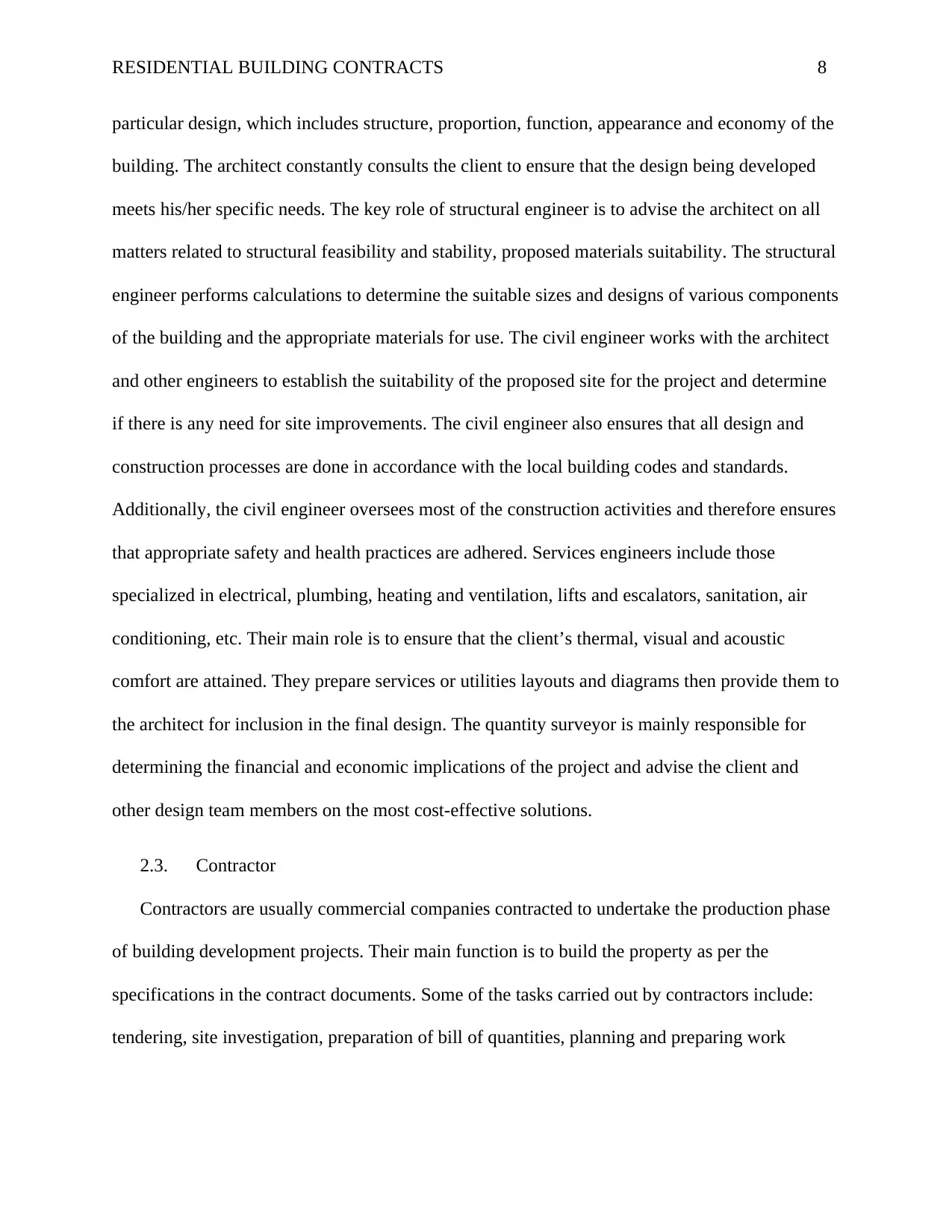
RESIDENTIAL BUILDING CONTRACTS 8
particular design, which includes structure, proportion, function, appearance and economy of the
building. The architect constantly consults the client to ensure that the design being developed
meets his/her specific needs. The key role of structural engineer is to advise the architect on all
matters related to structural feasibility and stability, proposed materials suitability. The structural
engineer performs calculations to determine the suitable sizes and designs of various components
of the building and the appropriate materials for use. The civil engineer works with the architect
and other engineers to establish the suitability of the proposed site for the project and determine
if there is any need for site improvements. The civil engineer also ensures that all design and
construction processes are done in accordance with the local building codes and standards.
Additionally, the civil engineer oversees most of the construction activities and therefore ensures
that appropriate safety and health practices are adhered. Services engineers include those
specialized in electrical, plumbing, heating and ventilation, lifts and escalators, sanitation, air
conditioning, etc. Their main role is to ensure that the client’s thermal, visual and acoustic
comfort are attained. They prepare services or utilities layouts and diagrams then provide them to
the architect for inclusion in the final design. The quantity surveyor is mainly responsible for
determining the financial and economic implications of the project and advise the client and
other design team members on the most cost-effective solutions.
2.3. Contractor
Contractors are usually commercial companies contracted to undertake the production phase
of building development projects. Their main function is to build the property as per the
specifications in the contract documents. Some of the tasks carried out by contractors include:
tendering, site investigation, preparation of bill of quantities, planning and preparing work
particular design, which includes structure, proportion, function, appearance and economy of the
building. The architect constantly consults the client to ensure that the design being developed
meets his/her specific needs. The key role of structural engineer is to advise the architect on all
matters related to structural feasibility and stability, proposed materials suitability. The structural
engineer performs calculations to determine the suitable sizes and designs of various components
of the building and the appropriate materials for use. The civil engineer works with the architect
and other engineers to establish the suitability of the proposed site for the project and determine
if there is any need for site improvements. The civil engineer also ensures that all design and
construction processes are done in accordance with the local building codes and standards.
Additionally, the civil engineer oversees most of the construction activities and therefore ensures
that appropriate safety and health practices are adhered. Services engineers include those
specialized in electrical, plumbing, heating and ventilation, lifts and escalators, sanitation, air
conditioning, etc. Their main role is to ensure that the client’s thermal, visual and acoustic
comfort are attained. They prepare services or utilities layouts and diagrams then provide them to
the architect for inclusion in the final design. The quantity surveyor is mainly responsible for
determining the financial and economic implications of the project and advise the client and
other design team members on the most cost-effective solutions.
2.3. Contractor
Contractors are usually commercial companies contracted to undertake the production phase
of building development projects. Their main function is to build the property as per the
specifications in the contract documents. Some of the tasks carried out by contractors include:
tendering, site investigation, preparation of bill of quantities, planning and preparing work
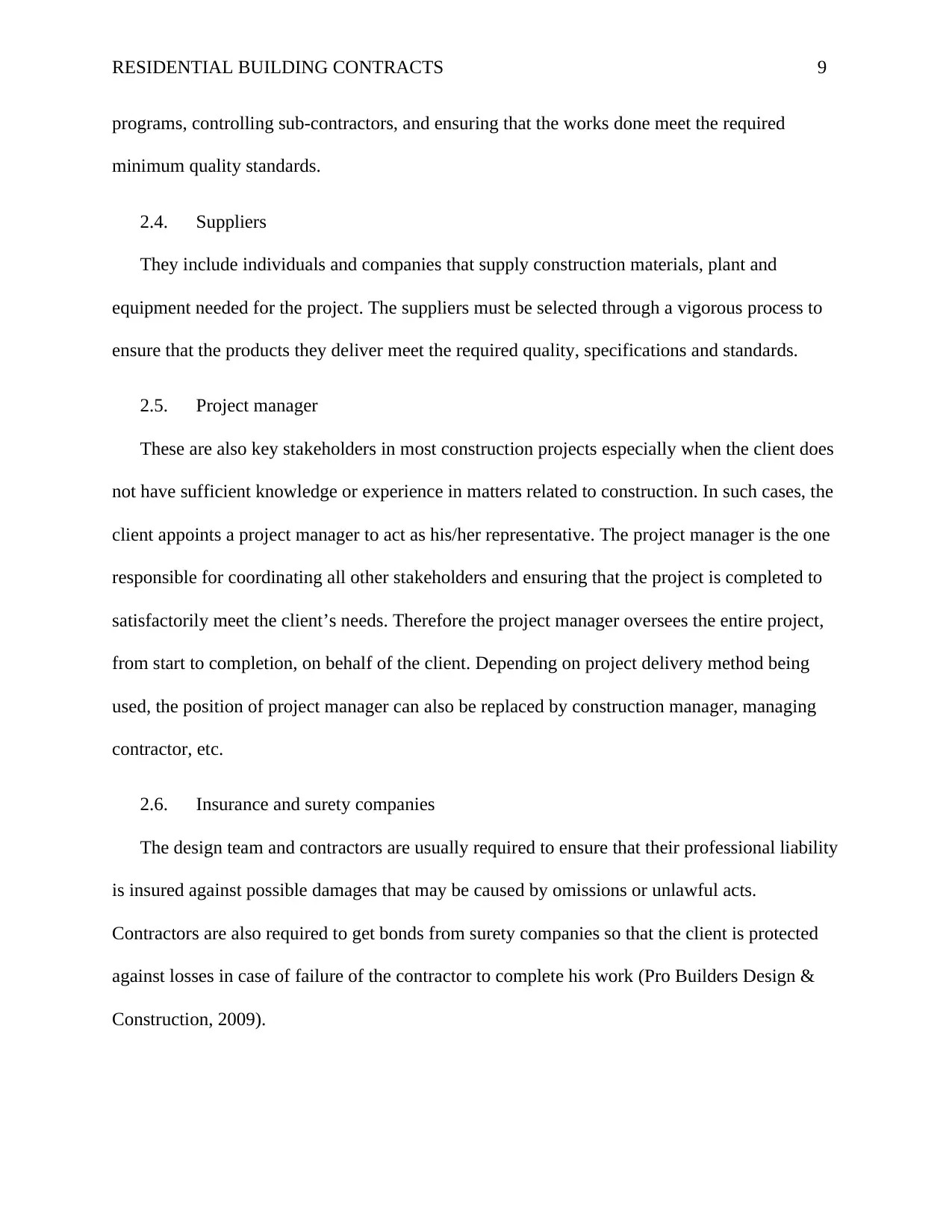
RESIDENTIAL BUILDING CONTRACTS 9
programs, controlling sub-contractors, and ensuring that the works done meet the required
minimum quality standards.
2.4. Suppliers
They include individuals and companies that supply construction materials, plant and
equipment needed for the project. The suppliers must be selected through a vigorous process to
ensure that the products they deliver meet the required quality, specifications and standards.
2.5. Project manager
These are also key stakeholders in most construction projects especially when the client does
not have sufficient knowledge or experience in matters related to construction. In such cases, the
client appoints a project manager to act as his/her representative. The project manager is the one
responsible for coordinating all other stakeholders and ensuring that the project is completed to
satisfactorily meet the client’s needs. Therefore the project manager oversees the entire project,
from start to completion, on behalf of the client. Depending on project delivery method being
used, the position of project manager can also be replaced by construction manager, managing
contractor, etc.
2.6. Insurance and surety companies
The design team and contractors are usually required to ensure that their professional liability
is insured against possible damages that may be caused by omissions or unlawful acts.
Contractors are also required to get bonds from surety companies so that the client is protected
against losses in case of failure of the contractor to complete his work (Pro Builders Design &
Construction, 2009).
programs, controlling sub-contractors, and ensuring that the works done meet the required
minimum quality standards.
2.4. Suppliers
They include individuals and companies that supply construction materials, plant and
equipment needed for the project. The suppliers must be selected through a vigorous process to
ensure that the products they deliver meet the required quality, specifications and standards.
2.5. Project manager
These are also key stakeholders in most construction projects especially when the client does
not have sufficient knowledge or experience in matters related to construction. In such cases, the
client appoints a project manager to act as his/her representative. The project manager is the one
responsible for coordinating all other stakeholders and ensuring that the project is completed to
satisfactorily meet the client’s needs. Therefore the project manager oversees the entire project,
from start to completion, on behalf of the client. Depending on project delivery method being
used, the position of project manager can also be replaced by construction manager, managing
contractor, etc.
2.6. Insurance and surety companies
The design team and contractors are usually required to ensure that their professional liability
is insured against possible damages that may be caused by omissions or unlawful acts.
Contractors are also required to get bonds from surety companies so that the client is protected
against losses in case of failure of the contractor to complete his work (Pro Builders Design &
Construction, 2009).
⊘ This is a preview!⊘
Do you want full access?
Subscribe today to unlock all pages.

Trusted by 1+ million students worldwide
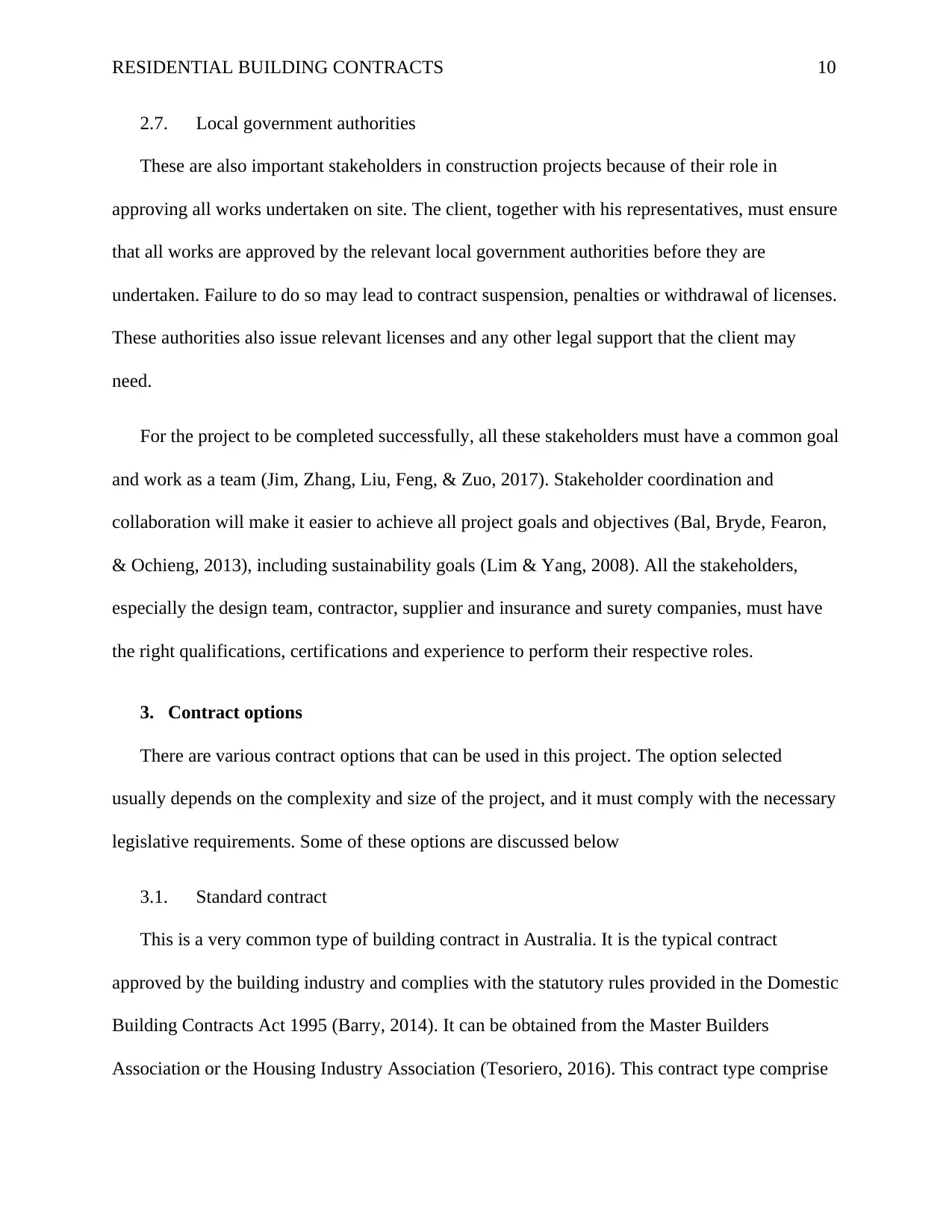
RESIDENTIAL BUILDING CONTRACTS 10
2.7. Local government authorities
These are also important stakeholders in construction projects because of their role in
approving all works undertaken on site. The client, together with his representatives, must ensure
that all works are approved by the relevant local government authorities before they are
undertaken. Failure to do so may lead to contract suspension, penalties or withdrawal of licenses.
These authorities also issue relevant licenses and any other legal support that the client may
need.
For the project to be completed successfully, all these stakeholders must have a common goal
and work as a team (Jim, Zhang, Liu, Feng, & Zuo, 2017). Stakeholder coordination and
collaboration will make it easier to achieve all project goals and objectives (Bal, Bryde, Fearon,
& Ochieng, 2013), including sustainability goals (Lim & Yang, 2008). All the stakeholders,
especially the design team, contractor, supplier and insurance and surety companies, must have
the right qualifications, certifications and experience to perform their respective roles.
3. Contract options
There are various contract options that can be used in this project. The option selected
usually depends on the complexity and size of the project, and it must comply with the necessary
legislative requirements. Some of these options are discussed below
3.1. Standard contract
This is a very common type of building contract in Australia. It is the typical contract
approved by the building industry and complies with the statutory rules provided in the Domestic
Building Contracts Act 1995 (Barry, 2014). It can be obtained from the Master Builders
Association or the Housing Industry Association (Tesoriero, 2016). This contract type comprise
2.7. Local government authorities
These are also important stakeholders in construction projects because of their role in
approving all works undertaken on site. The client, together with his representatives, must ensure
that all works are approved by the relevant local government authorities before they are
undertaken. Failure to do so may lead to contract suspension, penalties or withdrawal of licenses.
These authorities also issue relevant licenses and any other legal support that the client may
need.
For the project to be completed successfully, all these stakeholders must have a common goal
and work as a team (Jim, Zhang, Liu, Feng, & Zuo, 2017). Stakeholder coordination and
collaboration will make it easier to achieve all project goals and objectives (Bal, Bryde, Fearon,
& Ochieng, 2013), including sustainability goals (Lim & Yang, 2008). All the stakeholders,
especially the design team, contractor, supplier and insurance and surety companies, must have
the right qualifications, certifications and experience to perform their respective roles.
3. Contract options
There are various contract options that can be used in this project. The option selected
usually depends on the complexity and size of the project, and it must comply with the necessary
legislative requirements. Some of these options are discussed below
3.1. Standard contract
This is a very common type of building contract in Australia. It is the typical contract
approved by the building industry and complies with the statutory rules provided in the Domestic
Building Contracts Act 1995 (Barry, 2014). It can be obtained from the Master Builders
Association or the Housing Industry Association (Tesoriero, 2016). This contract type comprise
Paraphrase This Document
Need a fresh take? Get an instant paraphrase of this document with our AI Paraphraser
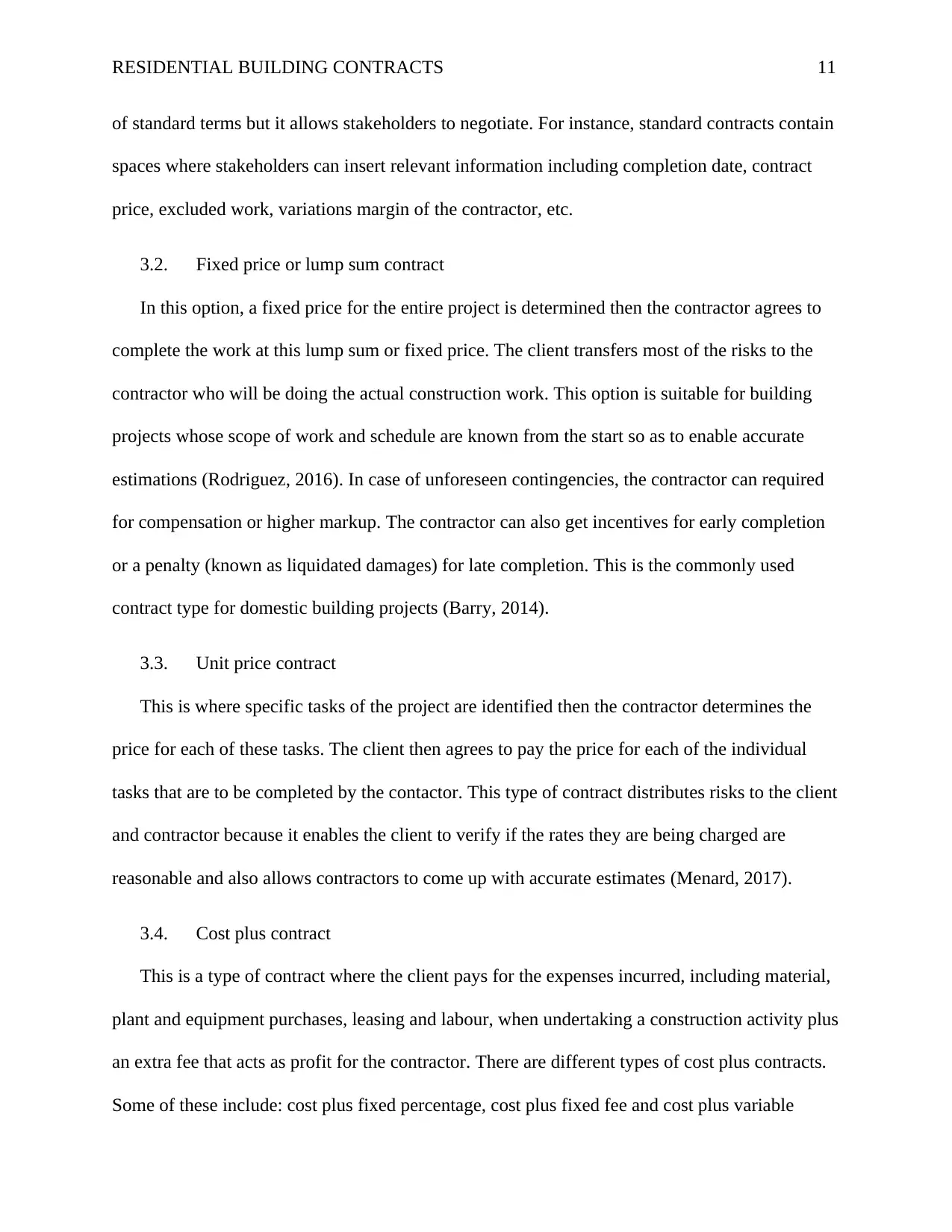
RESIDENTIAL BUILDING CONTRACTS 11
of standard terms but it allows stakeholders to negotiate. For instance, standard contracts contain
spaces where stakeholders can insert relevant information including completion date, contract
price, excluded work, variations margin of the contractor, etc.
3.2. Fixed price or lump sum contract
In this option, a fixed price for the entire project is determined then the contractor agrees to
complete the work at this lump sum or fixed price. The client transfers most of the risks to the
contractor who will be doing the actual construction work. This option is suitable for building
projects whose scope of work and schedule are known from the start so as to enable accurate
estimations (Rodriguez, 2016). In case of unforeseen contingencies, the contractor can required
for compensation or higher markup. The contractor can also get incentives for early completion
or a penalty (known as liquidated damages) for late completion. This is the commonly used
contract type for domestic building projects (Barry, 2014).
3.3. Unit price contract
This is where specific tasks of the project are identified then the contractor determines the
price for each of these tasks. The client then agrees to pay the price for each of the individual
tasks that are to be completed by the contactor. This type of contract distributes risks to the client
and contractor because it enables the client to verify if the rates they are being charged are
reasonable and also allows contractors to come up with accurate estimates (Menard, 2017).
3.4. Cost plus contract
This is a type of contract where the client pays for the expenses incurred, including material,
plant and equipment purchases, leasing and labour, when undertaking a construction activity plus
an extra fee that acts as profit for the contractor. There are different types of cost plus contracts.
Some of these include: cost plus fixed percentage, cost plus fixed fee and cost plus variable
of standard terms but it allows stakeholders to negotiate. For instance, standard contracts contain
spaces where stakeholders can insert relevant information including completion date, contract
price, excluded work, variations margin of the contractor, etc.
3.2. Fixed price or lump sum contract
In this option, a fixed price for the entire project is determined then the contractor agrees to
complete the work at this lump sum or fixed price. The client transfers most of the risks to the
contractor who will be doing the actual construction work. This option is suitable for building
projects whose scope of work and schedule are known from the start so as to enable accurate
estimations (Rodriguez, 2016). In case of unforeseen contingencies, the contractor can required
for compensation or higher markup. The contractor can also get incentives for early completion
or a penalty (known as liquidated damages) for late completion. This is the commonly used
contract type for domestic building projects (Barry, 2014).
3.3. Unit price contract
This is where specific tasks of the project are identified then the contractor determines the
price for each of these tasks. The client then agrees to pay the price for each of the individual
tasks that are to be completed by the contactor. This type of contract distributes risks to the client
and contractor because it enables the client to verify if the rates they are being charged are
reasonable and also allows contractors to come up with accurate estimates (Menard, 2017).
3.4. Cost plus contract
This is a type of contract where the client pays for the expenses incurred, including material,
plant and equipment purchases, leasing and labour, when undertaking a construction activity plus
an extra fee that acts as profit for the contractor. There are different types of cost plus contracts.
Some of these include: cost plus fixed percentage, cost plus fixed fee and cost plus variable
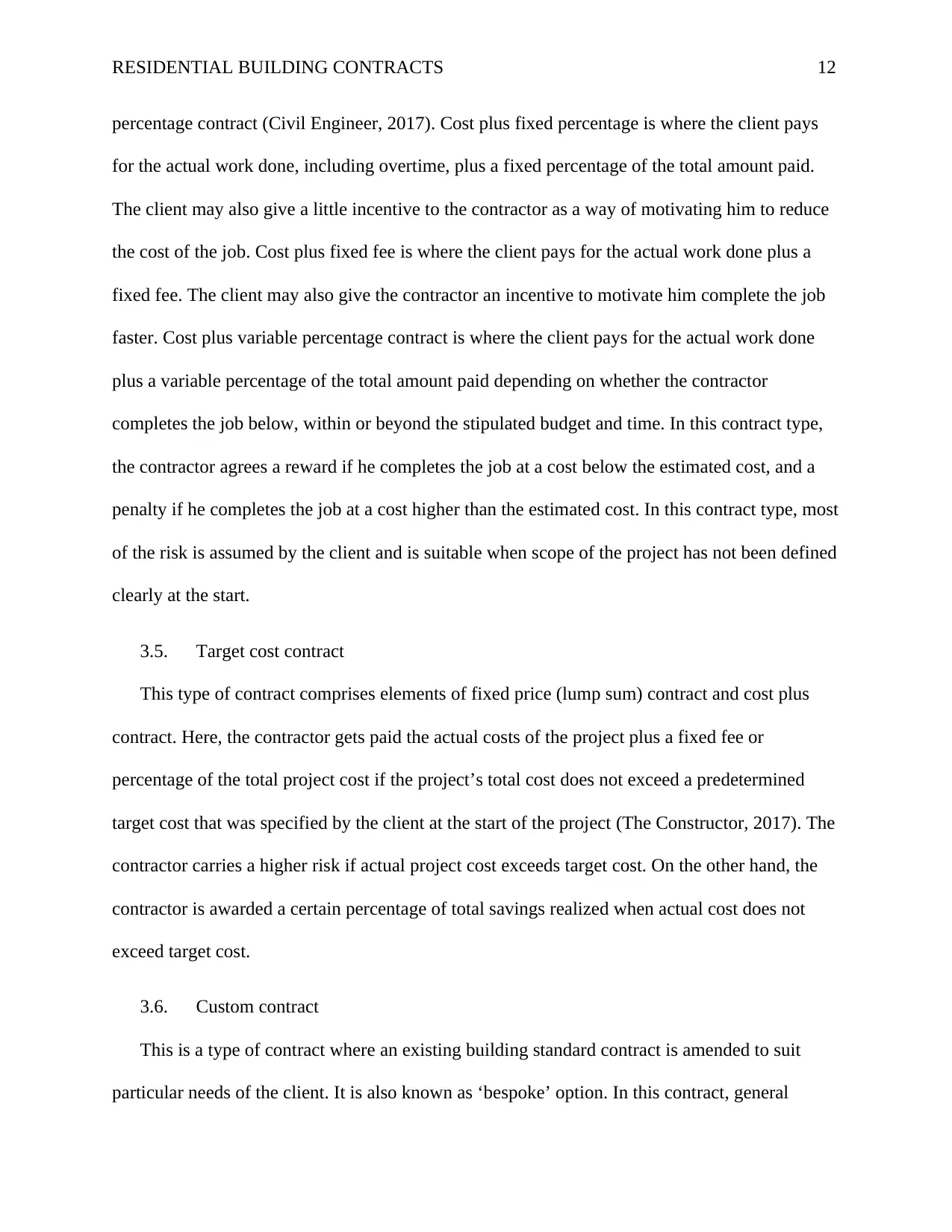
RESIDENTIAL BUILDING CONTRACTS 12
percentage contract (Civil Engineer, 2017). Cost plus fixed percentage is where the client pays
for the actual work done, including overtime, plus a fixed percentage of the total amount paid.
The client may also give a little incentive to the contractor as a way of motivating him to reduce
the cost of the job. Cost plus fixed fee is where the client pays for the actual work done plus a
fixed fee. The client may also give the contractor an incentive to motivate him complete the job
faster. Cost plus variable percentage contract is where the client pays for the actual work done
plus a variable percentage of the total amount paid depending on whether the contractor
completes the job below, within or beyond the stipulated budget and time. In this contract type,
the contractor agrees a reward if he completes the job at a cost below the estimated cost, and a
penalty if he completes the job at a cost higher than the estimated cost. In this contract type, most
of the risk is assumed by the client and is suitable when scope of the project has not been defined
clearly at the start.
3.5. Target cost contract
This type of contract comprises elements of fixed price (lump sum) contract and cost plus
contract. Here, the contractor gets paid the actual costs of the project plus a fixed fee or
percentage of the total project cost if the project’s total cost does not exceed a predetermined
target cost that was specified by the client at the start of the project (The Constructor, 2017). The
contractor carries a higher risk if actual project cost exceeds target cost. On the other hand, the
contractor is awarded a certain percentage of total savings realized when actual cost does not
exceed target cost.
3.6. Custom contract
This is a type of contract where an existing building standard contract is amended to suit
particular needs of the client. It is also known as ‘bespoke’ option. In this contract, general
percentage contract (Civil Engineer, 2017). Cost plus fixed percentage is where the client pays
for the actual work done, including overtime, plus a fixed percentage of the total amount paid.
The client may also give a little incentive to the contractor as a way of motivating him to reduce
the cost of the job. Cost plus fixed fee is where the client pays for the actual work done plus a
fixed fee. The client may also give the contractor an incentive to motivate him complete the job
faster. Cost plus variable percentage contract is where the client pays for the actual work done
plus a variable percentage of the total amount paid depending on whether the contractor
completes the job below, within or beyond the stipulated budget and time. In this contract type,
the contractor agrees a reward if he completes the job at a cost below the estimated cost, and a
penalty if he completes the job at a cost higher than the estimated cost. In this contract type, most
of the risk is assumed by the client and is suitable when scope of the project has not been defined
clearly at the start.
3.5. Target cost contract
This type of contract comprises elements of fixed price (lump sum) contract and cost plus
contract. Here, the contractor gets paid the actual costs of the project plus a fixed fee or
percentage of the total project cost if the project’s total cost does not exceed a predetermined
target cost that was specified by the client at the start of the project (The Constructor, 2017). The
contractor carries a higher risk if actual project cost exceeds target cost. On the other hand, the
contractor is awarded a certain percentage of total savings realized when actual cost does not
exceed target cost.
3.6. Custom contract
This is a type of contract where an existing building standard contract is amended to suit
particular needs of the client. It is also known as ‘bespoke’ option. In this contract, general
⊘ This is a preview!⊘
Do you want full access?
Subscribe today to unlock all pages.

Trusted by 1+ million students worldwide
1 out of 23
Related Documents
Your All-in-One AI-Powered Toolkit for Academic Success.
+13062052269
info@desklib.com
Available 24*7 on WhatsApp / Email
![[object Object]](/_next/static/media/star-bottom.7253800d.svg)
Unlock your academic potential
Copyright © 2020–2025 A2Z Services. All Rights Reserved. Developed and managed by ZUCOL.





